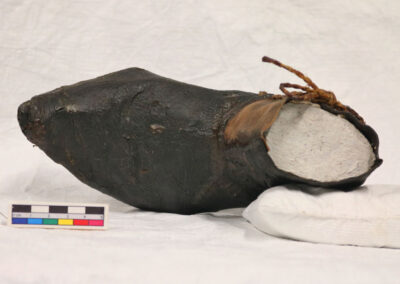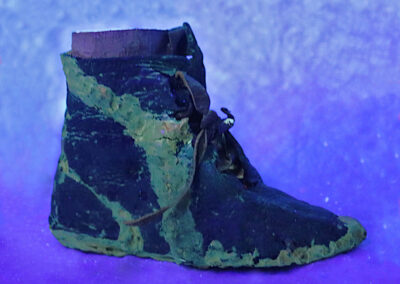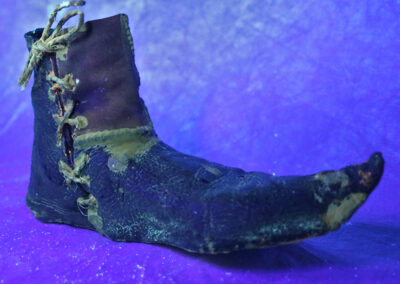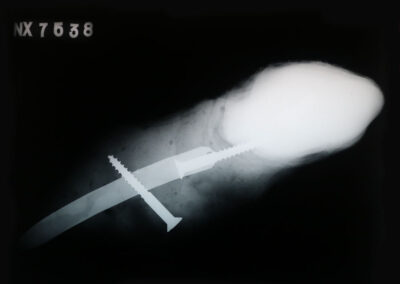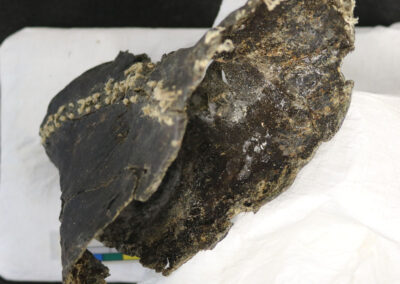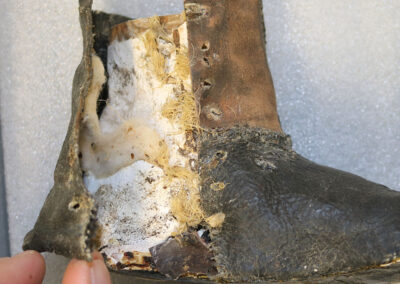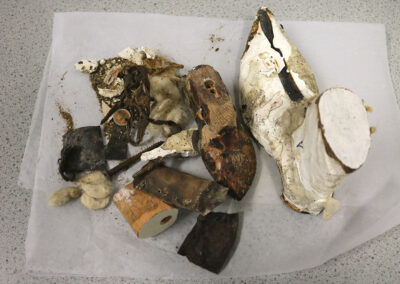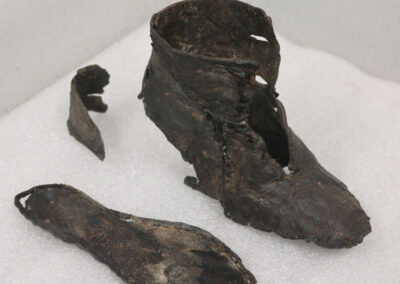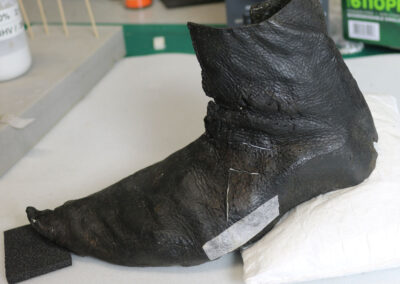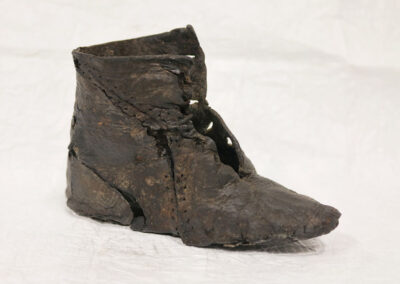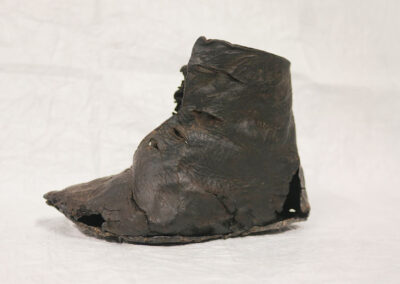The Conservation of Medieval Footwear
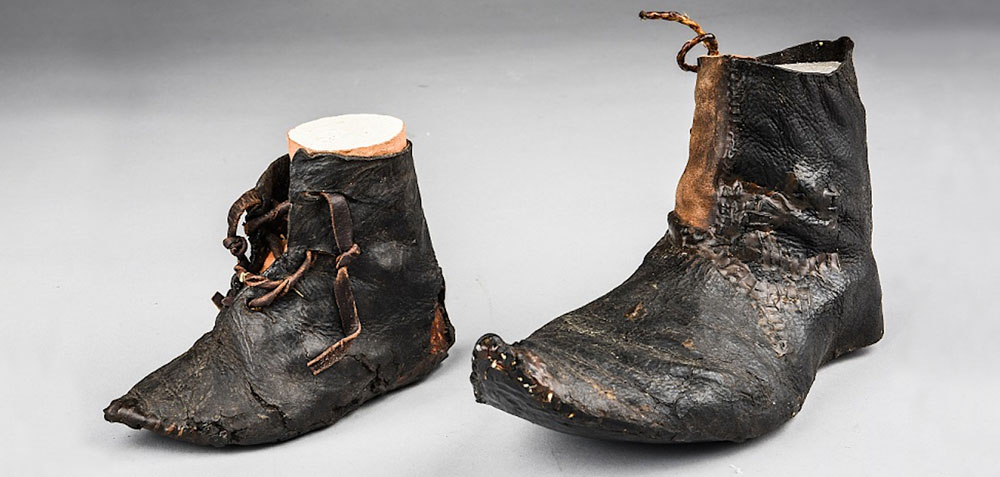
The two shoes were found during excavations by the Ministry of Works at St. Benedict’s Gate, Norwich in 1951 and entered Norwich Castle’s collection shortly after in 1952. They’re medieval leather working boots for the left foot ; one sized for a child, the other for an adolescent and date to the late 15th century or about 1500. Finding leather shoes this well preserved is extremely rare in our climate.
The amount of information we can extrapolate from rare finds such as these can really help us understand the day-to-day life of people during the medieval period. The child’s boot measures 14.6cm in length and would have originally been fastened with leather strips through slit lace holes. Many children’s shoes often show signs of repeated repair, perhaps due to the difficulties in taking them on and off. Evidence of foot deformation found in excavations from this time period also suggests that outgrown shoes continued to be worn and shoes would only be discarded when beyond repair. The adolescent’s boot measures 21.6cm in length and would have originally been fastened through the punched holes on the side. A piece of leather was missing when excavated where some of the lacing holes were situated, however this piece was restored so the lacing could be mimicked with twine. Both are made from cattle hide with tunnel stitching being used to attach the sole to the upper and once sewn together, the completed shoe would have been turned inside out. The process of inverting the shoe in its construction helps prevent deterioration and water leaking in by hiding the main seams. Footwear constructed using this method are known as turnshoes.
A Detailed Investigation
Prior to any intervention, the shoes needed to be carefully examined to assess what previous conserving methods were used to determine how best to proceed. All of the work was carried out in the conservation lab at the Norwich Castle Study Centre which is home a range of specialist equipment such as a x-radiography facility, fume extraction chambers , microscopes, industrial freezers and a plethora of conservator apparatus. The entire process was recorded for documentation purposes by Jonathan, which includes photographs and time-lapse videos.
Visual Inspection
Upon visual inspection with the naked eye, the shoes had been reconstructed, using wooden formers for the child’s shoe and Plaster of Paris poured around the inside, packed out with cotton wool for the adolescent shoe . They had been stitched and adhered together with modern twine and what appears to be copious layers of glue. A section of the larger shoe has had a piece of thick modern leather sewn to one side as an effort to fill a missing area and produce a more cohesive look. Black paint has also been applied liberally to areas of reconstruction to disguise the string and twine. An archaeological report tells us that some reconstruction was done post excavation in the 1950s, whilst some other work may have been carried out in the 1970-80s.
Ultraviolet Examination
Following the initial examination, the shoes were then studied under ultraviolet light which confirmed the extensive amount of adhesive used to hold everything together. The fluorescent areas reveal that an animal glue was used during previous treatments which has since become hardened and brittle. This type of adhesive is still used in conservation, but not in such copious amounts and untargeted application.
X-Radiography Analysis
Both items were then examined using x-radiography which revealed a number of surprising additions to the previous conservation treatments. Both shoes featured large screws inside their wooden and plaster formers with a hacksaw blade being used as some form of angled support on the adolescent shoe. Unsure of the type of metal in these additions, they could simply be untreated screws from the local hardware, which poses possible risk to the fragile leather if they were to rust.
Conclusion from Investigation
After reviewing all of the information from analysing the footwear, it was decided to intervene with a number of treatments to help preserve these objects to modern standards. The fragile leather of both shoes was to be carefully removed from the heavy formers and reconstructed using modern conservation methods and materials. Modern conservation practices aim to use, whenever possible, reversible adhesives and archival materials, well documented existing processes, sympathetic materials which will react in a similar way to the object, and to alter the original object as little as possible.
Deconstruction
A time-lapse montage of the deconstruction process of the adolescent shoe.
Reconstruction
Once separated and cleaned, the reconstruction process could begin. The leather pieces were carefully pieced back together using reversible and flexible adhesives with strips of light-weight Japanese ‘Kozo’ tissue paper to bridge each piece. The adhesives used were Lascaux 498HV & 360HV in a mixture of 3:1 with deionised water. Any exposed Japanese tissue joins were toned out using small amounts of colour matched conservation grade paints.
A time-lapse montage of the reconstruction process of the child’s shoe.
Completed Treatments
Adolescent’s Boot
Final Comments
The total time for each boot to be completed ; five days for the child’s shoe and four days for the adolescents shoe. Before the updated treatment was carried out, each shoe weighed significantly more. The child’s shoe went from 151 grams to 32 grams and the adolescents shoe went from 748 grams to just 46 grams and each piece can now support its own shape without the requirement of moulded formers. The treatment has completely stabilised the objects and they’re ready to be displayed for the public to see in the brand new Gallery of Medieval Life when Norwich Castle Keep reopens in 2024.
All conservation work was carried out and recorded by Jonathan Clark, Senior Conservator at Norfolk Museums Service.
Thank you Dr Agata Gomolka for providing additional insight on medieval footwear.
Public record file of the medieval shoes (NWHCM : 1952.63.1) – Norfolk Museums Collections




